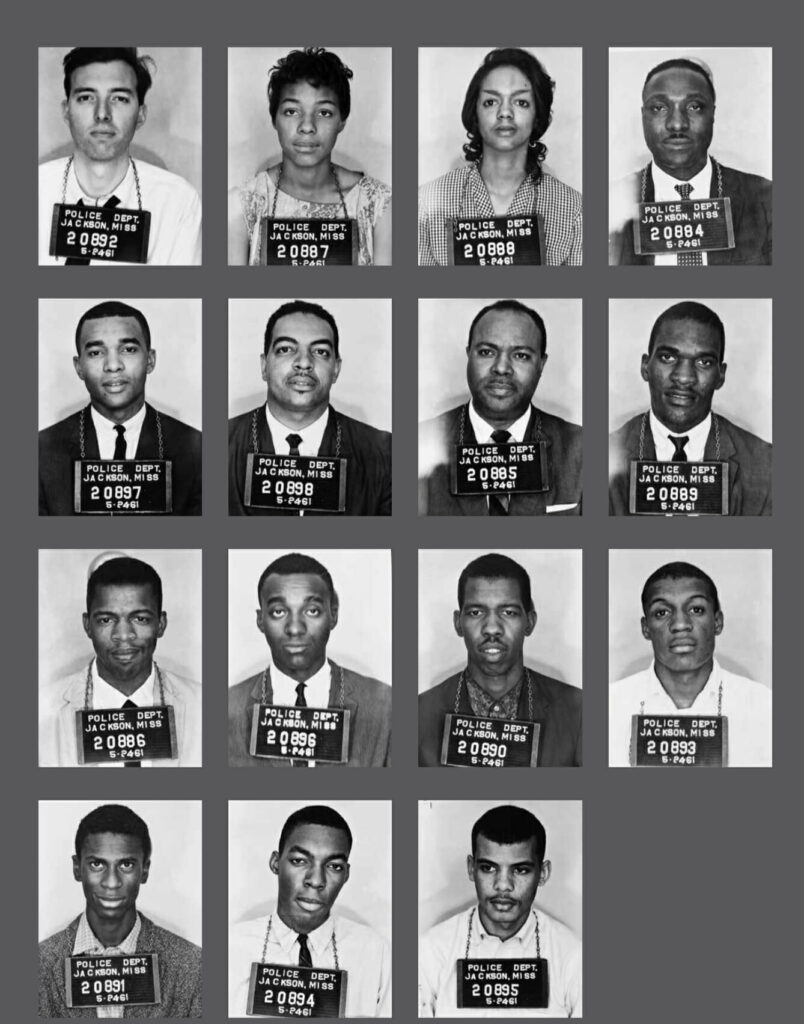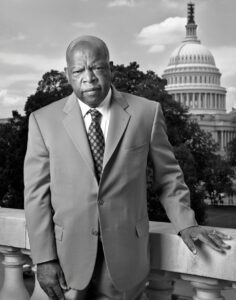Arts & Entertainment
Allen Boyer: “Breach of Peace” by Eric Etheridge, The 1961 Mississippi Freedom Riders Review
During the summer of 1961, in the early days of the civil rights era, busloads of Freedom Riders descended on the bus stations of Jackson. In the Deep South, at that time, any black traveler who used a whites-only bench or restroom, or any white traveler who used black facilities, risked arrest. The Freedom Riders, young men and women most of them, were determined to challenge segregation by civil disobedience. In Jackson, hundreds of them were arrested.

Mugshots from the archives of the Mississippi State Sovereignty Commission. (John Lewis is in the lower left-hand corner, one row up from the bottom, No, 20886).
Eric Etheridge, a veteran journalist who was born in Carthage and has worked as an editor in New York City, has devoted years to documenting this civil rights campaign. In 2008, he published a first volume of mug shots, commentary, and interviews with surviving Freedom Riders (an effort that won praise from the New Yorker). Vanderbilt University Press has now published an expanded edition of “Breach of Peace: Portraits of the 1961 Mississippi Freedom Riders.”
The first Freedom Riders reached Jackson on May 24 – twenty-seven of them in two buses. Their journey had already been eventful and violent. In Birmingham, police commissioner Eugene “Bull” Bull Connor allowed the Klan to attack them. John Lewis intervened to keep the buses rolling, taking a seat among those who continued. In Montgomery, where another group of Klansmen mobbed the buses, Lewis was bludgeoned with a wooden Coca-Cola crate.
In Jackson, there was no mob violence. Instead, National Guardsmen and police crowded the Riders off the bus into the white waiting room, then arrested them all for breach of the peace. By the end of the summer, 329 people had been arrested, the last being 15 Episcopal priests who arrived at the Continental Trailways bus station in mid-September. Typically, the Rider sentenced to pay a fine of $200.00 and serve 60 days in jail. The jail time was often suspended, but many Freedom Riders spent time at Parchman State Penitentiary.
Ironically, records kept by the Mississippi State Sovereignty Commission provide documentation of the comprehensive nature of which historians dream. Etheridge began by studying pages of mug shots.
“Placed before the camera, some of the Riders look down or away; others meet its gaze with their own. As portraits, the mug shots are always compelling and frequently stellar. The police camera caught something special, even if no one quite intended it that way. I was captivated by these images . . . . I wanted to find the Riders today, to look into their faces, to make new portraits to set against the earlier photographs.”
Etheridge began interviewing Freedom Riders in 2005. Some refused to be photographed; about 80 had died.
What the Riders made of their lives is absorbing. Some Riders were what the State Sovereignty Commission suspected they were – conscientious objectors and Yale Divinity School students and hangers-on of the Fair Play for Cuba Committee. Many more would be community organizers, activists, school aide, social welfare agency staffers. There were young educated white women who found the warden at Parchman unsure of how to handle this new species of prisoner. There were future science professors; there were women who went on to teach pregnancy prevention and Lamaze childbirth classes.

John Lewis. Photo by Eric Etheridge.
There was a future Congressman – John Lewis had kept riding west from Montgomery. There were Quakers who prayed so earnestly that less devout cellmates complained. The group numbered one future Fuller Brush salesman and one future real-estate developer, and a black preacher who carried a pistol until Martin Luther King persuaded him to put it up.
By 2008 Etheridge had completed 82 profiles; this book includes 98. Twenty provide extended interviews. They discuss the hostility they found in Mississippi, the conditions they endured while held at Parchman Prison Farm, and the reasons each had for boarding the bus.
Particularly eloquent is Jessie Davis, a native of Jackson. Davis went on to organize for fair housing and to work with abused children, the developmentally disabled, and the homeless. “When I first walked into that church,” he wrote of a rally at Greater Blair AME Zion Church, “I felt somewhat liberated. But when they put me in the paddy wagon, I felt like the chains had fallen off.”
“Breach of Peace: Portraits of the 1961 Mississippi Freedom Riders.” By Eric Etheridge. Expanded Edition; published by Vanderbilt University Press. 239 pages. $29.95.
Allen Boyer is the Book Editor of HottyToddy.com.

















You must be logged in to post a comment Login